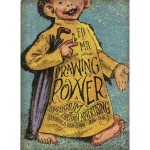
By many and various, edited by Rick Marschall & Warren Bernhard (Fantagraphics Books & Marschall Books)
ISBN: 978-1-60699-399-6
From its earliest inception cartooning has been used to sell: initially ideas or values but eventually products themselves. In newspapers, magazines and especially comicbooks the sheer power of narrative with its ability to create emotional affinities has been linked to the creation of unforgettable images and characters. When those stories affect the daily lives of generations of readers the force that they can apply in a commercial arena is almost irresistible…
Popular culture historian Rick Marschall and biographer/researcher Warren Bernhard have compiled here a captivating potted history of the rise of the art of commercial cartooning in an increasingly advertising-aware America (…and make a strong argument that one could not have thrived without the other) whilst providing a glorious panoply of staggeringly evocative, nostalgic and enduring picture-poems which shaped the habits of a nation. This volume covers the birth of the medium until the outbreak of World War II – which will be tackled in a subsequent book.
After Marschall’s compelling and intoxicating discourse on the growth of the twin industries in ‘Cartoons and the Selling of America’ the individual chapters of copiously illustrated memorabilia commence with ‘The Origins of Cartoon Advertising’ featuring truly magical art from the likes of Joseph Keppler, Thomas Nast, Frederick Burr Opper, Clare Victor “Dwig†Dwiggins, Winsor McCay and others for Beef Tea, Steinway pianos, insurance, wines, “electric†cigarettes, washing powder, sausages, entertainments and political rallies after which the legendary R.F. Outcault stars in the first Portfolio Section.
The creator of Hogan’s Alley, The Yellow Kid, Buster Brown and so many others was the first cartoonist to cut out the commercial middleman and directly market his skills as a pioneering advertising executive with his own agency in 1907 and this 10-page gallery is stuffed with his incredible inventions and innovations.
‘Cartoon Ads Go to War’ celebrates the patriotic fervour engendered by masters of brush and pen such as Ralph Barton, Rose (“Kewpiesâ€) O’Neill, Charles Dana Gibson, McCay again, John T. McCutcheon and many more with the attendant Portfolio piece dedicated to ‘Sheet Music’ illustrations from Homer Davenport, Outcault, McCay, George McManus, Russell Patterson, Rube Goldberg and more, illustrating a growing trend – the licensing of established strip characters and stars to “endorse†and sell products.
‘The Jazz Era’ spotlights a graphic Golden Age both for advertising and newspaper strip merchandising: everything from promotional postcards to personalised calendars, decoder rings and assorted premium statuettes. Here the portfolio features illustrated blotters (absolutely vital in an era when most transactions where inscribed using fountain pens) starring such cartoon heavyweights as Mutt and Jeff, Bull of the Woods, They’ll Do It Every Time, Krazy Kat, Mickey Mouse and Donald Duck, Bringing Up Father, the Gumps and William Heath Robinson.
Another portfolio covers the left-wing cartoonists who openly thrived in the USA in the days before Communism became a dirty word and Liberal Tendencies a hanging offence. Contributors include Otto ‘the Little King’ Soglow, Art Young, Syd Hoff AKA “A. Redfieldâ€, Herbert Johnson, Charles Sykes, John Held Jr., after which the ‘Tobacco’ industry gets its own section with terrifyingly effective contributions from Outcault’s Yellow Kid, Martin Branner’s Winnie Winkle, Bud Fisher’s Mutt and Jeff plus original strips from Frank Godwin, Ann “Fish†Septon, James Pinkney, Winsor McCay, Nicholas Afonsky and others.
The depression era is dissected in ‘Hard Times and Good Times’ concentrating on food, nutrition and making ends meet in strips drawn by Ludwig Bemelman, Opper and others whilst the Portfolio concentrates on ‘Baseball’ with strips starring celebrities such as Babe Ruth and Dizzy Dean – by a variety of unnamed artists – promoting the benefits of everything from grape nuts to cigarettes.
After which another selection of strip promotions and premiums highlights school supplies from Buck Rogers, comic masks from Wrigley’s gum, star buttons, Popeye transfers and more.
A ‘Celebrities’ Portfolio focuses on the selling power of tennis ace Big Bill Tilden, western stars Tom Mix and Andy Devine, movie comedians Jimmy Durante, Joe E. Brown and many more whose stars have faded with time.
Theodore Geisel gets an entire section to himself under his cartoon alter ego of Dr. Seuss and ‘Cartoonists as Pitchmen’ examines the phenomenon of artists as celebrities with Peter Arno, James Montgomery Flagg, Rube Goldberg, Sidney “The Gumps†Smith, Ham Fisher and others plugging a variety of goods and services after which Tom Heintjes recounts the story of the cartoonists ad agency ‘Johnstone and Cushing’, with illustrations from such employees as William Sakren, Creig Flessel, Albert Dorne, Austin Briggs, Lou Fine, Stan Drake and more.
This magnificent and beautiful collection concludes with an examination of perhaps the most effective cartoon advertising symbol ever created. ‘Mr. Coffee Nerves’ was designed to sell a vile-tasting, caffeine-free ersatz coffee named Poston – which it successfully did for 40 years – probably due to the entertaining scripts and superb art of artists such as Noel Sickles and Milton Caniff…
Stuffed with astounding images, fascinating lost ephemera and mouth-watering photos of toys and trinkets no fan could resist, this colossal collection is a beautiful piece of cartoon Americana that will delight and tantalise all who read it… and the best is yet to come.
This edition ©2011 Fantagraphics Books and Marschall Books. All text ©2011 Rick Marschall except ‘Johnstone and Cushing’ ©Tom Heintjes. All Rights Reserved.
